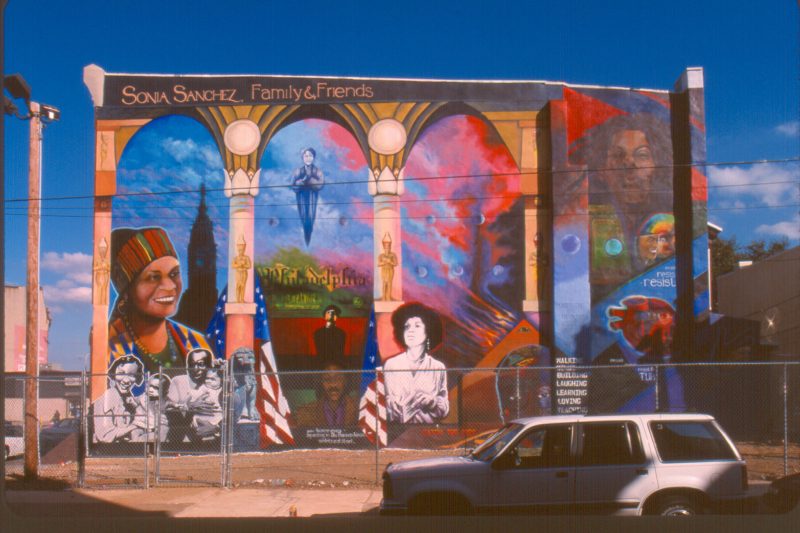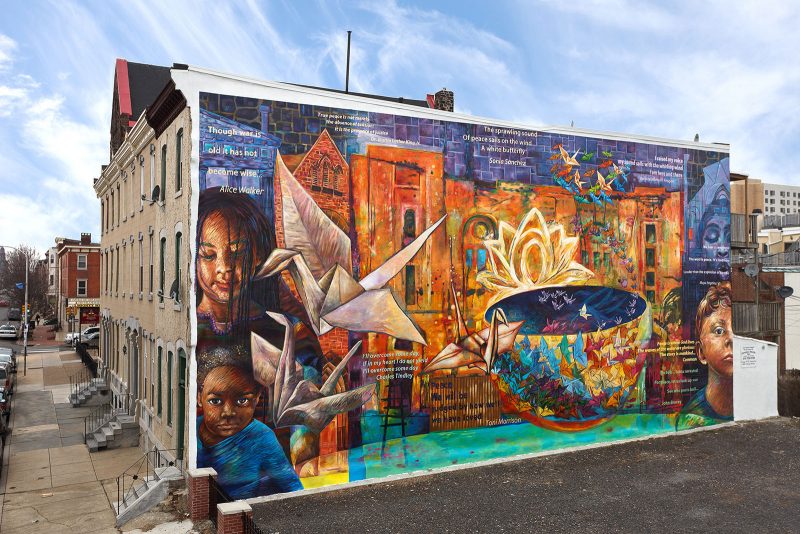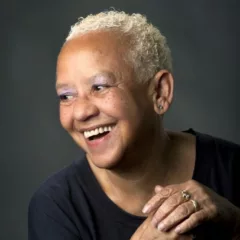
“Language is the most dangerous of professions.” – Sonia Sanchez
Sonia Sanchez is a familiar figure in Philadelphia, and beyond. In “BaddDDD Sonia Sanchez,” a documentary about her life, Sanchez says that she writes in order to explain how she became the woman with “razor blades between her teeth.” An ardent and sometimes strident poet and civil rights activist, Sanchez, now 81, has spent over five decades employing the power of language, brilliantly and influentially, to provoke and promote change, self-empowerment, and self-determination on behalf of and in the African American community, and particularly on behalf of African American women. She has also been an activist on behalf of the entire community in support of world peace.
Art Sanctuary’s 32nd Annual Celebration of Black Arts Festival concluded this year on May 31, with a showing of “BaddDDD Sonia Sanchez.” The documentary was produced and directed by Janet Goldwater, Barbara Attie, and Sabrina Schmidt Gordon. The African American Museum hosted the event, which included a discussion with Ms. Sanchez and Ms. Attie. The film took five years to complete and features jazz-accompanied performances of Sanchez’s work and, in testament to her profound influence upon the Black Arts Movement, cameos from poet Nikki Giovanni, rapper Talib Kweli, historian John H.Bracey, Jr., Roots drummer Questlove, and others including Ursula Rucker, Amiri Baraka, Haki Madhubuti, Jessica Care Moore, Ruby Dee, Yasiin Bey, Ayana Mathis, Imani Uzuri, and Byonn Bain. The trailer for the documentary can be viewed on YouTube.
Blowing the roof off
As a young woman Sanchez studied with the poet Louise Bogan, and the documentary recounts a story in which Sanchez asks Bogan whether she has talent. Bogan’s response: “Yes, you have talent, now let’s see whether you are going to do anything with it.” And indeed, Sanchez did so much with her talent. Through her poetry she spoke to and about the oppressed with a voice that resonated throughout the Black Arts Moment that followed her groundbreaking work. Through her social and political activism, she spoke out boldly against injustice and for peace. In the documentary, Talib Kweli credits Sanchez for making it possible for Hip-Hop to exist: “She didn’t just kick off the doors, she blew off the roof.” In fact, Sanchez blew off many roofs. Summing up the importance of her work, for which, among many other honors, she won the American Book Award (1985) and the Harper Lee Award (2004), Kalamu ya Salaam concluded in the Dictionary of Literary Biography: “Sanchez is one of the few creative artists who have significantly influenced the course of black American literature and culture.”
In addition to documenting the course of Sanchez’s personal life, her literary life, and her life as an educator–beginning in Alabama, with stops along the way in New York, Amherst, and San Francisco, and ending in Philadelphia–the documentary surveys the route of her five decades of activism, touching upon her involvement in CORE, The Children of Malcolm, the Black Power Movement, the Black Arts Movement, the Black Studies Movement, the Black Panthers, and The Nation of Islam. Above all, the film portrays a powerful, principled woman on a mission, speaking out against and standing up to injustice wherever she encounters it–whether in the curricula of respected educational institutions or in the misogyny of Eldrich Cleaver–demanding and reclaiming self-respect for herself and for her community, and urging her sisters and brothers to do the same. Ms. Sanchez’s father appears throughout the documentary, and throughout his daughter’s life, beseeching her, for her own sake and for the sake of her family, to stop making waves, to keep her mouth shut. But that was a path that Sonia Sanchez would not take, could not take, no matter what price she had to pay.
Sanchez’s discovery of black literature
In one of the most poignant, and I think important, scenes in the film, 19-year old Sonia Sanchez is just out of Hunter College and determined to get a job as a writer. It is the early 1950s. Thinking she has succeeded in landing a job, Sanchez shows up for work but is denied the position, she thinks as a result of discrimination. Intending to report the employer to the Urban League, she takes the subway uptown, gets off at the wrong stop, and wanders into the library of the Schomburg Center on 135th Street, where she is informed by the librarian, Jean Blackwell Hudson, that the library collects books by and about African Americans. Reflecting upon her own education at a time in which there was no such thing as Black Studies, she said to Ms. Hudson: “You must not have many books then.” Hudson then brought Sanchez copies of Souls of Black Folks, by W.E.B. Du Bois, Up from Slavery, by Booker T. Washington, and Their Eyes Were Watching God, by Zora Neale Hurston, and changed Ms. Sanchez’s life forever. Ms. Sanchez describes and reflects upon this experience in a video.
Sanchez in Philadelphia
Sonia Sanchez moved to Philadelphia in 1976, and her presence has been felt deeply here. Among many other things, as a professor at Temple University (1977-1999), she spearheaded the black and women’s studies programs, and in 2011 she became the first Poet Laureate of the City. I learned for the first time in the film that she testified as a character witness in the controversial trial of Mumia Abu-Jamal. And she lamented the MOVE tragedy in this poem.
Elegy (for Move and Philadelphia)
1.
philadelphia
a disguised southern city
squatting in the eastern pass of
colleges cathedrals & cowboys.
philadelphia, a phalanx of parsons
and auctioneers
modern gladiators
erasing the delirium of death from their shields
while houses burn out of control.
2.
c’mon girl hurry on down to osage st
they’re roasting in the fire
smell the dreadlocks and blk/skins
roasting in the fire.
c’mon newsmen and tvmen
hurryondown to osage st and
when you have chloroformed the city
and after you have stitched up your words
hurry on downtown for sanctuary
in taverns and corporations
and the blood is not yet dry.
3.
how does one scream in thunder?
4.
they are combing the morning for shadows
and screams tongue-tied without faces
look, over there, one eye
escaping from its skin
and our heartbeats slowdown to a drawl
and the kingfisher calls out from his downtown capital
and the pinstriped general reenlists
his tongue for combat
and the police come like twin seasons of drought and flood.
they’re combing the city for life liberty and
the pursuit of happiness.
5.
how does one city scream in thunder?
6.
hide us O lord
deliver us from our nakedness.
exile us from our laughter
give us this day our rest from seduction
peeling us down to our veins.
and the tower was like no other. amen.
and the streets escaped under the
cover of darkness amen.
and the voices called out from
their wounds amen.
and the fire circumcised the city amen.
7.
who anointeth the city with napalm? (i say)
who giveth this city in holy infanticide?
8.
beyond the mornings and afternoons
and deaths detonating the city.
beyond the tourist roadhouses
trading in lobotomies
there is a glimpse of earth
this prodigal earth.
beyond edicts and commandments
commissioned by puritans
there are people navigating the breath of hurricanes.
beyond concerts and football
and mummers strutting their
sequined processionals.
there is this earth. this country. this city.
this people.
collecting skeletons from waiting rooms
lying in wait. for honor and peace.
one day.

The poetry of peace
In 2001, the Mural Arts Program dedicated a mural to Sonia Sanchez. The artist was James Dupree, and the mural sits at the corner of Diamond and Carlisle Streets in North Philadelphia. It is pictured here. Then in 2012, the Mural Arts Program completed “Peace is a Haiku Song,” at 1425 Christian Street. That mural, executed by artists Josh Sarantitis and Parris Stancell, also pictured here, was designed to engage the local community in an exploration of the haiku as a vehicle for peace and urban transformation. The mural honors the poet and was “inspired by Sanchez’s belief that the haiku form is inherently non-violent in its intent and structure and engenders beauty, serenity, and brief reflection.” The mural incorporates haikus from citizens as well as poems Sanchez collected from the likes of Toni Morrison, Maya Angelou, and Alice Walker.
A wonderful segment of the documentary features Ms. Sanchez’s classic role in what was called the Granny Peace Brigade. In 2006, a group of 11 activist women including Sanchez, primarily grandmothers, marched to the Military Recruitment Center in Philadelphia demanding to enlist so that their grandchildren would not kill or be killed in the war in Iraq. They were arrested and eventually the charges were dismissed, and the group continued to resist United States war-making in Iraq, Afghanistan, and elsewhere.
When a person dedicates his or her life to activism, to confronting injustice wherever it is encountered, with the passion of a Sonia Sanchez, it inevitably takes a toll upon one’s family, and some of the formidable challenges that Ms. Sanchez faced both in marriage and as a parent are touched upon in the documentary. Although I think to a great extent she has kept her personal life private, in response to a question about her children, about how difficult it was for her to have and raise her children and at the same time to remain totally committed to her life as a poet and community and political activist, Ms. Sanchez remarked, I thought not without a suggestion of sadness: “I have many other children.”
For a breathtaking example of Sonia Sanchez’s work, which demonstrates the powerful, authentic moral authority of her voice, you can see and hear her performing her “Poem for Some Women,” about a woman who leaves her child in a crack house. And see here for more about her life and work, and about the documentary.
Barbara Attie, Janet Goldwater, and Sabrina Schmidt Gordon
A word about the filmmakers. Barbara Attie and Janet Goldwater have been making documentaries for many years, and their work, which often focuses upon social justice issues affecting women and girls, such as reproductive rights, violence against women, and female genital mutilation, has been recognized with a Pew Fellowship in the Arts in 2005 and a Leeway Transformation Award in 2012. “BaddDDD Sonia Sanchez,” in which they collaborated with Sabrina Schmidt Gordon, is their third profile of an extraordinary woman. The first two were “Maggie Growls” (2003), the biography of the founder of the Gray Panthers, Maggie Kuhn, and “Landowska: Uncommon Visionary” (1999), which explored the accomplishments of the pioneering harpsichordist, Wanda Landowska.
Ms. Schmidt Gordon produced and edited “Documented,” a documentary about Jose Antonio Vargas, a journalist who outed himself as an undocumented immigrant, and “Hip-Hop: Beyond Beats and Rhymes,” about manhood and gender politics in Hip-Hop. Attie, Goldwater, and Schmidt Gordon previously collaborated on “Mrs. Goundo’s Daughter” (2009), the story of a Malian woman who took on the U.S. immigration system to fight for political asylum to protect her 2-year old daughter from the same severe act that she suffered as a child–female genital mutilation.
Art Sanctuary
Art Sanctuary is “dedicated to bringing Philadelphians together through the unique community-building power of black art.” Its programs include an Author Series (featuring African American writers), a Storytelling Circle for preschoolers, North Stars (teaching about the Civil Rights Movement in City schools), Hip H’opera (with Opera Philadelphia), Read With Me: The MLK Project (studying Martin Luther King’s 1963 “Letter from a Birmingham Jail”), Art Sanctuary Teaching Artist Council (for art educators), and Black Professionals Got Talent! The organization also runs a gallery at 628 S. 16th Street, currently showing Posing Beauty, by Deborah Willis.









